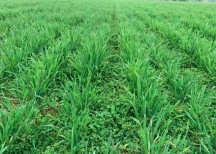By Jerry Alford. Innovative Farmers and Dominic Amos, Organic Research Centre
This Innovative Farmers project brings together organic and conventional notill farmers to investigate the potential for implementing a long-term system with the aim of maintaining a perennial living mulch of white clover whilst growing an annual combinable cash crop. The benefits are widespread, from reduced inputs for conventional farmers to a reduction in cultivations for the organic farmers in the group. This is where the trial is most fascinating because it Is a coming together of two farming systems who want to get the best out of their systems, whilst using the best of other people’s systems.
Organic farming is well known for having a set of principles based around a systems approach with minimal external inputs and conservation ag also has a set of principles it adheres to, being diversity, cover crops and minimal soil disturbance. The trial combines these principles and with sponsorship by Organic Arable, research input from The Organic Research Centre, technical advice form Cotswold Seeds and coordination from AHDB it is a trial that has a broad base of interest.
The basis of the trial is a permanent clover understorey which provides mulching, fertility and soil protection into which annual combinable crops are planted. There are two very important services the mulch will provide; weed suppression and nitrogen accumulation. In addition, the system should enhance soil physical characteristics, selfregulation of pests and diseases and increased biodiversity, both above and below ground. The living mulch system makes use of practices already common with cover cropping and elements of intercropping including undersowing and relay cropping. There are 6 farmers involved, farming from Shropshire to Suffolk, organic and conventional and each have different soils, systems and equipment. The one similarity is they are all using the same clover mix of 70% wild white and 30% medium leaf white clover as the understorey mix supplied by Cotswold seeds.
The Innovative Farmers programme takes farm trials already being carried out by farmers and introduce more structured experimentation to merge science and practice. It also brings groups of farmers together to create more of a “collective experiment” To that end the farmers will all grow the same mulch and should all include a control plot that represents current standard farm practice. This will provide a relevant comparison for agronomy, production and economics allowing new conclusions to be drawn about the effects of the new living mulch system. Without controls, effects on crop yield or weed control cannot be established. Data will be collected from living mulch and control plots at key times over the next two growing seasons and will constitute measurements of cash crop, cover crop and weed biomass, and soil mineral nitrogen as well as yield and grain quality supplied by the farmers. Establishment of the clover has been difficult and variable this spring with the very dry April and May. The clover will be monitored and following harvest this year may require a “top-up”.
As this group of farmers has developed, the amount of experimentation that has already been carried out has become apparent with one of the organic farmers growing cereals with a trefoil understorey for some years. For him, the slightly lower yield that has been achieved has been balanced economically by the ability to grow more combinable crops in his rotation without so many fertilitybuilding breaks and a slight increase in the protein content of the triticale. Another farmer has tried wheat sown into a mulch of either red or white clover with rye grass which ended up offering too much competition with the cereal and the trial was eventually taken as a wholecrop for silage. For other organic farmers, undersowing has been a feature for many years and in long term organic systems, white clover is a common ‘weed’ and so it makes sense to utilise it rather than fight it. Direct drilling into a grazed off ley has been a common organic farmers experiment, but often with mixed outcomes.
For the conventional farmers, reduction in chemical inputs, particularly nitrogen, are an important consideration with the drive for zero carbon farming putting fertiliser inputs in the firing line. Profitability rather than production at all costs being an important factor in their business planning. This means conventional no-till will have both economic and environmental drivers to reduce inputs.
For others, attempting to get something out of a disaster has led to an opportunistic undersowing experiment. Field lab member Marcus Struthers from Courteenhall Estate,Northampton, explains -We had a failed WOSR field (7ha) last year which we drilled with white clover and took it through till the autumn with fantastic establishment. This we drilled directly into it around December time, which was later than we wanted but the weather held us back, surprisingly though this field has been looking the best on the farm all season, with minimal inputs and only the 2 chemical passes to date. Due to the results we have seen this year, with a relatively small area we have increased it this spring under sowing 35 ha of Spring Barley with white clover and another 11.5ha with a clover and black oat mix.
For us it is an exciting time, being able to cut chemical applications, introduce rouging where necessary, weed suppression, increase soil health etc.
The different farmers in the group are also seeing different potential problems, and the benefits of an interactive approach using webinars (due to Covid-19) and WhatsApp has allowed discussion.
The wet autumn and winter of 2019/20 have delayed this trial from its original start date and so we are just at a start-up stage, with the dry spring affecting mulch planting. Again, different experiences come to play with a more relaxed view from organic farmers who are used to undersowing but are also used to not doing anything to growing crops when they are drilled. Different techniques are also apparent here with some mulches direct drilled into existing crops, and others drilling with spring crops following rain. In one case the clover is being grown under a buckwheat crop, which is itself an experiment.
Following crops will mainly be wheat or oats, although any combinable crop including maize, can in theory, be used. However, the most vigorous and competitive winter crops such as rye or oats may make most sense particularly in the early stages of the new system as this will maximise the competitive ability of the crop against both mulch and weeds. Research indicates that it may take a few seasons for the new system to bed in and in terms of nitrogen cycling and crop availability, this looks to be higher in the second season.

The difficulty will be reducing competition on the germinating crop at the critical seedling period. Research shows that the dominant biomass when growth starts in the spring tends to be the winner, and so a relay cropping type approach is envisaged with the autumn crop being drilled as the mulch slows its growth due to reducing temperatures and day length. The key here is that a winter cereal will continue to grow through this period, tillering and developing its root system whilst the clover remains dormant. This may explain why the organic farmers who grazed their direct drilled crops off in the winter had mixed results. The concept of critical weed free period (i.e how long weed competition needs to be absent in order not to reduce grain yield) has been well established for decades.
The key to achieving a functional living mulch system with a tolerable yield reduction will involve maximising the competitive ability of the cash crop while selectively weakening the cover crop at key stages. With the mulch mix already selected for its complementarity as an intercrop, the organic farms have only cash crop species selection, drilling date and drilling method to influence the cash and cover crop dynamic. Of course with herbicides and nitrogen fertiliser, conventional no-till farmers have two additional tools at their disposal to help hand the competitive advantage to the cash crop, boost yield and control weeds if the mulch doesn’t offer enough of the service provision the farmers are looking for, namely weed control and N-accumulation.
For the experienced no-tillers, weed control is not seen as an issue because experience says that minimal disturbance leads to less weeds germinating whereas the organic farmers see a strip till type system being advantageous, possibly keeping mulched and cropped strips in the fields to minimise competition to the future crops. Certainly, research has shown that the longer the mulch can be kept from the base of the cash crop, the lower the yield reduction will be. Providing a channel for the growth and development of the crop at least during the foundation and early construction phases is likely to be important with the clover a stolon former it will close in any gaps and provide full groundcover by harvest. One of the benefits of an established perennial mulch may be improved trafficability and one of the farmers involved is considering a spring wheat like Mulika drilled in January that will give enhanced early vigour and establishment to grow away from the mulch before it gets going in the spring.

Control of the mulch growth is a key component of the trial and there are 2 stages which are important, prior to or just after drilling and during the spring when the crop will need to gain both water, and nutrients, in direct competition with the clover. One area being looked at is the possibility of mowing between rows (cf. inter row hoeing) to mulch the clover but there are crimpers and rollers being used elsewhere which achieve the same objective. It is important to release some of the nitrogen produced by the clover at times when the crop needs it, because clovers do not release the nitrogen without a reason and will stop producing nitrogen if there is too much available. For conventional farmers there are chemical, including fertiliser, options to manage the clover mulch but these are not possible for the organic farmers.
Autumn grazing with sheep is seen as the preferred option for those farmers with livestock but mulching the crop, crimping or rolling on a frost are alternatives that will suit stockless systems. The advantage of the living mulch approach is that there is no soil disturbance to stimulate weeds and the living plant will continue to suppress further germination. There are obviously potential problems, and areas where we need more knowledge-what about grass weeds and in particular blackgrass? What about perennial weeds? And what effect will the mulch have on crop yields and will the economics only work with organic prices. These can only be resolved by research and this is where the Innovative Farmers field labs are so effective, small scale projects which test hypotheses and look on tramline or plot scale with researcher input in trial design, data collection and interpretation.
